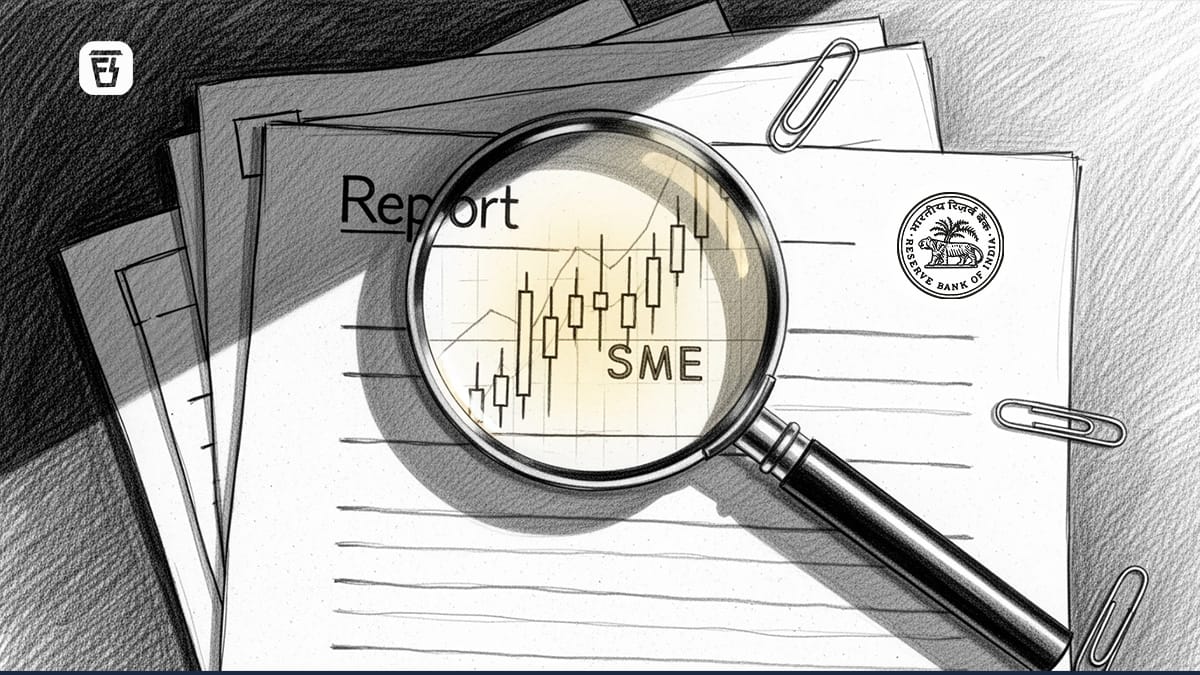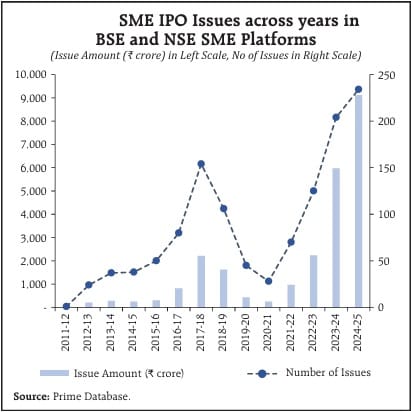RBI breaks down the SME IPO hype

In today’s Finshots, we take a look at RBI’s latest report on the SME (Small and Medium Enterprises) IPO hype.
The Story
Over the past couple of years, we’ve written a couple of stories on SME IPOs (here and here). And if you’ve been with us through those and kept up with the news, you’d have spotted one common link. Most of these IPOs reek of price manipulation and shady dealings.
More often than not, we’ve tried to break things down and warn you about why these listings deserve extra caution. Sure, due diligence is essential for any investment, but this bunch has earned a reputation for being the bad apples in the basket.
Nevertheless, what has always puzzled us is why, despite all the red flags, retail investors keep rushing into SME IPOs.
Well, turns out we didn’t have to dig too deep to find the answer. Because this time the RBI just rolled up its sleeves, did all the heavy lifting, and published a detailed study about how the whole thing snowballed into a bubble.
And to unpack it, let’s start by going back to a time when SME IPOs didn’t even exist.
Look, SMEs have always struggled to raise money. Banks rarely trusted them because there wasn’t enough history or reliable information about their business or cash flows. Even today, about 22% of small Indian firms say lack of finance is their biggest problem.
This issue goes back to India’s post-independence policies. Small-scale industries like handicrafts and village-based manufacturing were seen as engines of rural employment, so the government protected them. It even reserved hundreds of products exclusively for small firms, blocking large companies from competing. But this protection had side effects. Many of these businesses stayed tiny forever. They didn’t invest in technology or expand because they never had to face competition. And as a result, India ended up with lots of micro firms and a few large companies, but hardly any midsized ones. Something that economists called the problem of the “missing middle”.
Then came economic reforms in the mid-1980s and 1990s. The country opened up, competition increased, and small businesses suddenly needed capital to grow. But banks were still unwilling to lend, and equity markets weren’t built for small players. So, the idea of a stock market platform just for SMEs began taking shape.
The first attempt was the OTCEI (Over The Counter Exchange of India) in 1989. It was meant to help smaller firms raise funds, but it failed due to low investor interest. The second attempt, BSE IndoNext in 2005, also fizzled out due to similar reasons.
And the real breakthrough only came in 2012 when BSE SME Exchange and NSE Emerge were launched. They relaxed rules on minimum IPO size, capital requirements, and compliance and reporting norms. And suddenly, going public became possible for SMEs.
The impact was dramatic. SME IPO listings jumped from just 1 in 2012 to over 200 by 2024. And fundraising went from ₹7 crores to a whopping ₹5,900 crores! In the last year alone, SME IPO fundraising has shot up 52%.

And with this rapid growth came questionable activity. SEBI began sniffing around and found irregularities. And although there isn’t official data to say how bad it was, market veteran Vijay Kedia claims that 90% of SME IPOs are manipulated.
But then, how did such huge interest in SME IPOs even begin, you ask?
You see, till around 2018, SME IPOs were a quiet corner of the market. The BSE SME and NSE Emerge platforms were still new, and most investors treated them like an experiment. You could say that they were a way to dabble in smaller companies outside the large-cap universe.
Then came the 2019 to 2021 period, when sentiment weakened, Covid hit, and SME listings slowed down. But once the pandemic settled, the space exploded for three simple reasons.
To begin with, trading became ridiculously easy. Discount broker apps and paperless IPO applications lowered the entry barrier. SME IPOs also allowed tiny application sizes, so retail investors could join the party even with small capital.
Second, UPI and ASBA (Application Supported by Blocked Amount) changed the game. Investors no longer had to pay upfront. They could simply block funds in their bank accounts during IPO applications. That made applying as easy as ordering food online.
Third, state governments like Maharashtra, Gujarat, Tamil Nadu and Rajasthan stepped in and began offering incentives like subsidies on listing costs to encourage SMEs to go public. That pulled more companies into the IPO pipeline.
And then the madness began. To put things in perspective, between January and June 2023, just 7 SME IPOs were oversubscribed 100 times or more. But after July 2023, that number more than quadrupled to 32!
Retail behaviour shifted too. Earlier, people bought SME IPOs out of curiosity or for diversification from mainstream sectors. But after 2023, it turned into a pure listing gain chase, thanks to news and social media hype around “multibagger IPOs”.
Merchant bankers (the folks who handle due diligence, prepare documents and market the IPO) also added fuel to the fire. In mainboard IPOs, big brand names, say, LIC, Zomato or Tata group firms, do most of the selling because everyone knows them. But SME IPOs come from companies most people have never heard of. So when investors can’t judge the business, they rely on the reputation of the banker handling the IPO instead. The RBI even found that SME IPOs handled by reputed bankers had twice the subscription levels compared to others because investors simply trusted them more.
But there’s another layer to this. In SME IPOs, merchant bankers must also act as market makers for three years after listing. That means the must ensure that there are always buy and sell offers so that the stock doesn’t freeze due to low trading volumes. For retail investors, that feels like a safety net. Someone is always there to keep the stock liquid, at least on paper. So in many ways, trust in SME IPOs wasn’t built on company fundamentals.
The bigger thing was that more younger investors became part of the market. The median investor age dropped from 38 in 2019 to 33 in 2025. And when they saw SME IPOs doubling on listing day, with gains touching 400% in extreme cases, they rushed in. The RBI suggests that between FY24 and FY25, 87% of SME IPOs on NSE and 91% on BSE listed at a premium. Compare that to mainboard IPOs that usually deliver 10‒40% gains, and you’ll see why they didn’t stand a chance to compete against SMEs.
All of this translated into applications shooting through the roof. In FY23, there were just 4 SME IPO applicants for every allottee. But by FY25, that number had exploded to 245 applicants for every single allottee!
And that’s how early scepticism around SME IPOs flipped into full-blown euphoria. From struggling to raise capital, SMEs suddenly had more money chasing them than they could take.
But there was one notable exception — Qualified Institutional Buyers (QIBs) like mutual funds and insurance companies, who mostly stayed away, despite SEBI trying to pull them in. Because here’s the catch. Unlike retail investors, these institutions looked at fundamentals. And many SME IPOs were simply overvalued and unstable.
When the RBI’s study tracked SME IPOs over the last two financial years and compared them with mainboard IPOs to understand this, they found a stark difference.
It saw that after a month, mainboard IPO prices moved in a controlled way, while SME IPOs showed big gains for some and sharp drops for others. After 3 months, mainboard returns stayed steady but SME IPOs continued to swing wildly. And after 6 months, most mainboard IPOs were still stable, while many SME IPOs crashed below their listing price.
And the worst crashes? They happened in IPOs where retail investors had applied aggressively.
Basically, so many people piled in, that prices got artificially inflated. At one point, nearly 20% of SME IPOs were trading at unjustified valuations or at P/E ratios much higher than their industry peers.
Naturally, all that frenzy eventually forced SEBI to step in. The regulator didn’t want retail investors blindly following the herd into risky SME IPOs. So in 2024 it quietly raised the entry barriers. The minimum application size was proposed to be doubled from ₹1 lakh to ₹2 lakh, making it harder for casual punters to treat SME IPOs like lottery tickets. It also increased the minimum number of allottees from 50 to 200 so that a small group of insiders couldn’t corner the entire issue. And to ensure that only genuine businesses made it to the market, it introduced an operating profitability filter. SMEs would now need to show at least ₹1 crore in operating profit in two of the previous three financial years before going public. In short, SEBI simply made sure that only serious investors and real companies walked through them.
Even NSE came up with its own set of rules for these IPOs.
So yeah, that’s what the RBI dug into. And its message is simple…
Don’t get carried away by market euphoria. As the old saying goes, “Bull markets are born on pessimism, grow on scepticism, mature on optimism, and die on euphoria.”
The SME IPO rush may look exciting today, but hype doesn’t last forever. And when the music stops, someone gets left holding the bag. And if you’ve read this story, the least you can do is make sure it isn’t you.
Until next time…
If this story gave you better insight into why retail investors are so crazy about SME IPOs, share it with your friends, family, or even strangers on WhatsApp, LinkedIn, or X. And tell them to subscribe too!
Did you know? Nearly half of Indians are unaware of term insurance and its benefits.
Are you among them?
If yes, don’t wait until it’s too late.
Term insurance is one of the most affordable and smartest steps you can take for your family’s financial health. It ensures they do not face a financial burden if something happens to you.
Ditto’s IRDAI-Certified advisors can guide you to the right plan. Book a FREE 30-minute consultation and find what coverage suits your needs.
We promise: No spam, only honest advice!
